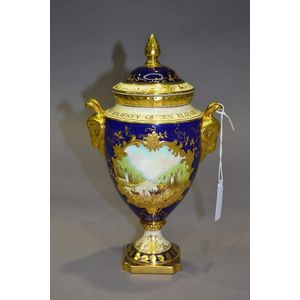Embossed Coalport Gravy Tureen with Stand, 1825
You must be a subscriber, and be logged in to view price and dealer details.
Subscribe Now to view actual auction price for this item
When you subscribe, you have the option of setting the currency in which to display prices to $Au, $US, $NZ or Stg.
- Circa - A Latin term meaning 'about', often used in the antique trade to give an approximate date for the piece, usually considered to be five years on either side of the circa year. Thus, circa 1900 means the piece was made about 1900, probably between 1895 and 1905. The expression is sometimes abbreviated to c.1900.
- Embossed / Repousse - Embossing, also known as repousse, is the technique of decorating metal with raised designs, by pressing or beating out the design from the reverse side of the object.It is the opposite of chasing, where the decoration is applied from the front. An embossed or repoussed object may have chasing applied to finish off the design.
- Polychrome - Made or finished in many colours. For furniture, it is used to indicated a painted finish.
- Grapevine Motif - The grapevine motif is a decorative design that features grapevines, leaves, and grapes and is commonly used in various forms of art and decoration, including jewellery, textiles, pottery, and architecture.
In jewellery, the grapevine motif is often used to create decorative elements such as pins, brooches, necklaces, and bracelets. The design can be executed in a variety of materials, including precious metals such as gold and silver, and can be embellished with gems or enamel.
The grapevine motif is a popular symbol in many cultures, representing abundance, prosperity, and fertility. In ancient times, grapevines were associated with Dionysus, the Greek god of wine and celebration, and were used to decorate wine vessels, temples, and other sacred objects.
In addition to its cultural significance, the grapevine motif is also appreciated for its aesthetic appeal. The intertwining branches and clusters of grapes create a graceful, flowing design that is both beautiful and versatile. Whether used in jewellery, textiles, or other forms of decorative arts, the grapevine motif continues to be a popular and enduring symbol of abundance and prosperity.
This item has been included into following indexes:
Visually similar items

A Chinese export ware tureen and dish, early to mid 20th century, of typical oval tureen form with pierced bracket handles, the stepped dome lid with a gilt finial, decorated to reserves with European scenes of rural pursuits, and further embellished with

Royal Worcester lidded potpourri bowl by Kitty Blake hand painted with berries and heavily gilded with reticulated neck and cover, dated 1942-48, shape number H165, signed K Blake. Height 15 cm

Coalport twin handled urn 'The Honour of her Majesty Queen Elizabeth II' (has firing cracks to handl. Coalport twin handled urn 'The Honour of her Majesty Queen Elizabeth II' (has firing cracks to handle area), approx 24 cm high

A Chamberlains Worcester tureen, stand & cover of Adams urn shape. Gilt borders with painted sepia and magenta floral sprays (early written mark) c.1790. Width 25 cm
